One word seems to precede any references to the SEND system nowadays: broken. This is the (paraphrased) view of, among many others, National Audit Office, the Education Select Committee and many parents. The sector is awaiting the government’s plan for reforms.
We have looked before at the rise in numbers of pupils with Education, Health and Care Plans (EHCPs) since the introduction of the current SEND Code of Practice.
In this article, we are going to recap some of this, then identify some areas where additional specialist provision is most needed.
Data
We use data from the January School Census and from the Local Authority Alternative Provision (LAAP) Census from 2015 to 2024.
LAAP covers pupils educated outside the state-funded school sector but where local authorities are paying fees. This includes pupils placed in independent schools and FE colleges as well as those receiving other provision, such as home tutoring. LAAP is distinct from state-funded Alternative Provision (AP) schools[1].
Together, these two data sources provide us with details of all pupils of compulsory school age who are placed in state-funded schools or who are being educated outside the state-funded sector but where the local authority is paying fees.
This gives us, in theory, an almost complete picture of pupils of compulsory school age with EHC plans in January each year. However, we will be missing any pupils who were unplaced (for whatever reason) at the time.
Some pupils are recorded in more than one school in School Census and a small number appear in both School Census and LAAP Census. We include one record per pupil in our analysis, favouring pupils’ most recent enrolments where they are enrolled at more than one, and favouring school records over LAAP records where pupils have both.
Transitional arrangements were in place in the early years of the data series following the introduction of 2014 SEND Code of Practice. As a result, we include pupils with statements of special educational needs as well as those with EHC plans.
Number of pupils with EHC plans
First, let’s look at the number of pupils of primary school age with EHCPs.
Although we show data from 2015, we are mainly concerned with the period 2018 to 2024 as numbers of pupils with EHCPs have increased markedly since then.
We can see that the overwhelming majority of primary-age pupils with EHCPs are educated in mainstream schools, and these numbers have doubled since 2018, from 67 thousand to 137 thousand.
There has been a similar rate of increase, albeit from a lower base, among pupils in LAAP, from 3,300 in 2018 to 6,300 in 2024.
Numbers of pupils with EHCPs in special schools have also increased, albeit at a much slower rate, from 45 thousand in 2018 to 60 thousand in 2024.
Now let’s turn to pupils of secondary school age with EHCPs.
As at primary, there are more pupils with EHCPs in mainstream schools than in special schools but this has not always been the case over the last 10 years.
Between 2018 and 2024, the number of pupils aged 11-15 with EHCPs in mainstream schools has increased from 49 thousand to 94 thousand, a 93% increase.
Over the same period, the number of similarly aged pupils in special schools has increased from 55 thousand to 80 thousand, a 47% increase.
Meanwhile, the number in LAAP has more than doubled from 8,900 to 22,200.
Specialist Resourced Provision and SEN units
Some pupils attending mainstream schools are assigned to Specialist Resourced Provisions (SRPs) or SEN units.
For a good overview of these different types of provision head to the Special Needs Jungle.
The difference between an SRP and a SEN unit is not always clear. But, briefly, the idea is that SRPs enable pupils to (mostly) attend mainstream classes, with SRP staff providing support to meet pupils’ needs.
On the other hand, pupils assigned to SEN units will typically be taught in the unit.
The number of pupils taught in SRPs has increased in recent years, particularly in the primary phase.
However, there has been no such increase in pupils taught in SEN units over the same period, and a decrease in secondary.
Numbers attending SRPs are relatively small. Of the 137 thousand primary-age pupils with EHC plans attending mainstream schools in 2024, just 8,400 (6%) are observed to attend SRPs, though it is possible there is some under-recording in School Census.
Some data on the achievement of pupils with EHC plans placed in mainstream schools is available in Annex 1 for primary schools and Annex 2 for secondary schools.
Primary SEN type
In the following table we show the number of pupils with EHC plans in 2024 by their primary SEN type.
Among both primary-aged and secondary-aged pupils, the most common primary SEN type is Autistic Spectrum Disorder (ASD).
The second and third most common types are speech, language and communication needs (SLCN) and social, emotional and mental health (SEMH) needs. However, their positions are reversed: there are more pupils of primary age with SLCN as a primary SEN type than SEMH and more pupils of secondary age with SEMH as a primary SEN type than SLCN.
Many SRPs have a specialism. We do not observe this directly in School Census but we can attempt to infer it based on the modal type of primary need observed for each pupil with an EHCP.
Around 75% to 80% of pupils attending an SRP have a primary SEN type that matches the inferred specialism of the school.
In the chart below we show the number of schools with at least one pupil attending an SRP, classified by inferred specialism. It is possible that some schools have more than one SRP (and more than one specialism) but we leave that to one side for now.
In general, we see an increase in SRPs specialising in Autism (ASD), a reduction in SRPs specialising in Speech, Language and Communication (SLCN), and a rather flat pattern in SRPs specialising in Hearing Impairment (HI) or Visual Impairment (VI).
SRPs with less common specialisms, including Physical Disability (PD), Social, Emotional and Mental Health (SEMH) needs and Moderate Learning Difficulties (MLD) appear to have declined in number.
Transition
Most pupils change schools between primary and secondary.
For pupils who were aged 10 (Year 6) in 2019, we tabulate the type of school attended at age 15 (Year 11) in 2024. Most pupils reach the end of Key Stage 4 at this age.
The overwhelming majority (87%) of pupils who attended special schools at age 10 continued to attend special schools at age 15.
Around half (52%) of those attending mainstream schools (excluding SRPs and SEN units) completed Key Stage 4 at a mainstream school. 29% did so at a special school.
Among those who attended a SRP or SEN unit at age 10, the most common destination was a special school (43% and 50% respectively). 16% of pupils who attended a SRP at 10 also did so age 15.
In other words, it is not necessarily the case that pupils with EHCPs who attend mainstream schools at primary will continue to do so at secondary.
This in turn begs two questions:
- Are mainstream schools prepared for the increasing numbers of pupils with EHC plans who will be coming through from primary schools over the next few years?
- If mainstream schools aren’t suitable for pupils with EHC plans, where else will they go?
Coldspots
To finish off, we identify the local authorities in need of additional specialist provision in the secondary phase.
We do this by calculating the rate of pupils aged 11 to 15 in local authority alternative provision as a percentage of all pupils aged 11 to 15 resident in the local authority and in state-funded education.
Full results can be found in this table.
We focus on the two most common primary SEN types: Autistic Spectrum Disorder and Social, Emotional and Mental Health needs. Pupils with EHC plans with these primary needs are growing in number and will continue to do so as pupils currently in primary schools move into secondary.
There are between 0.6 and 1 pupils with an EHC plan for ASD in local authority alternative provision per 100 resident pupils in two London local authorities (Merton and Richmond on Thames), an authority in the South East neighbouring London (Surrey) and one in Yorkshire (Barnsley).
All of these authorities have relatively high rates of secondary-age pupils with EHC plans for autism, at over 2.5 pupils in every 100.
Using the same criteria for pupils with EHC plans for SEMH in LAAP, we find coldspots in Tameside, Stockport and Cheshire East (North West), Hartlepool and Redcar and Cleveland (North East), North Lincolnshire (East Midlands), Stoke-on-Trent (West Midlands), Devon (South West), Norfolk (East).
Most of these areas also tend to have fairly high rates of pupils with EHC plans with SEMH as the primary need at around 2 to 3 pupils in every 100. However, rates are lower in Hartlepool, Stoke-on-Trent and North Lincolnshire.
Summing up
The number of pupils with EHC plans has been increasing rapidly in recent years and the rate of increase is showing no signs of abating.
Although there has been an increase in the number of pupils attending special schools, this has not been accompanied by an increase in the number of schools, as a recent TES article shows.
As a result, the number of pupils attending mainstream schools have increased sharply, along with numbers placed by local authorities outside the state-funded sector.
In some areas in particular, there are relatively large numbers of secondary-aged young people with EHC plans for ASD or SEMH for whom there is no suitable provision in the state-funded school estate.
Creating suitable additional provision in these areas ought to be a goal of whatever SEND plans the government comes up with.
This is urgent given the increasing numbers of pupils with EHC plans coming through from primary schools.
- Pupil Referral Units and Alternative Provision Academies and Free Schools
Want to stay up-to-date with the latest research from FFT Education Datalab? Sign up to Datalab’s mailing list to get notifications about new blogposts, or to receive the team’s half-termly newsletter.



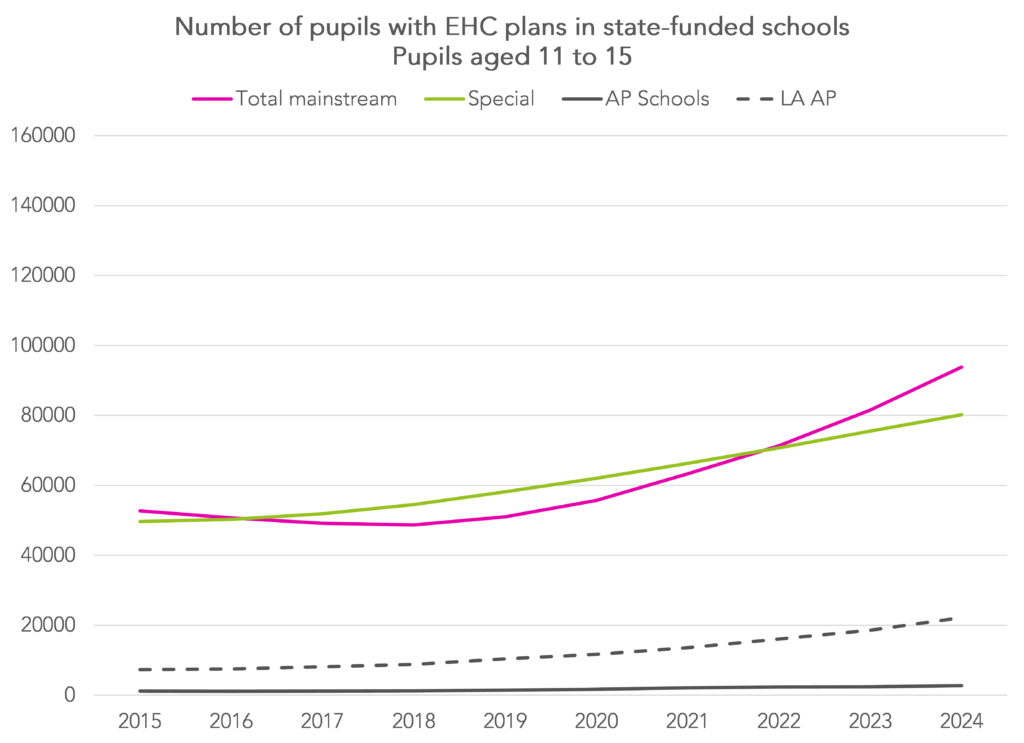
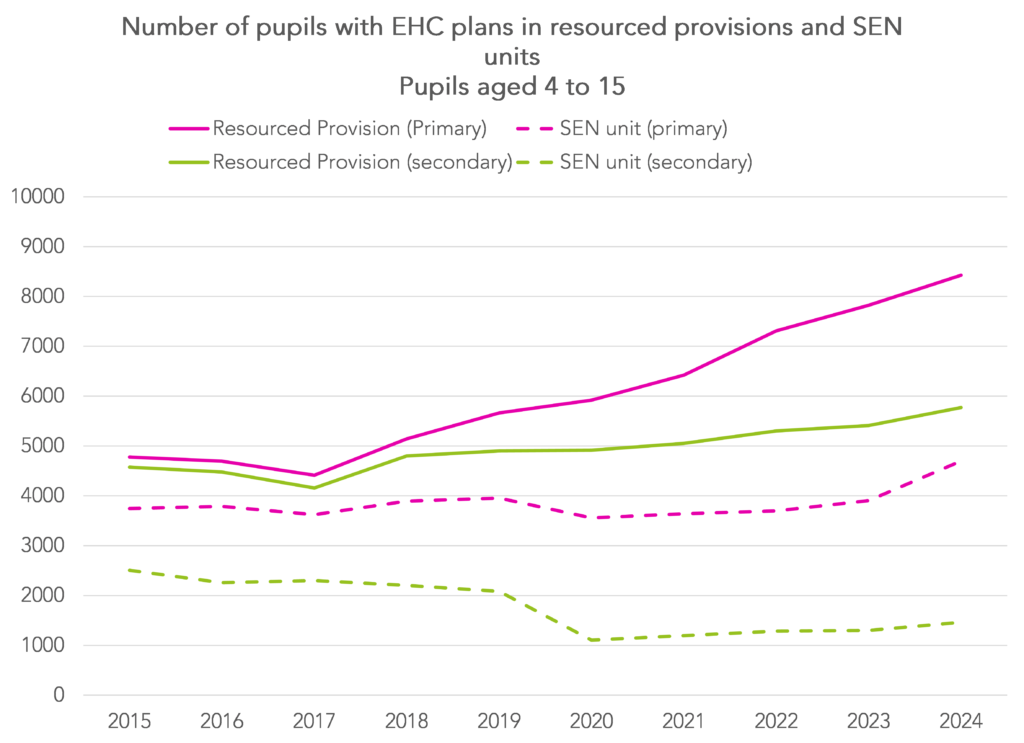
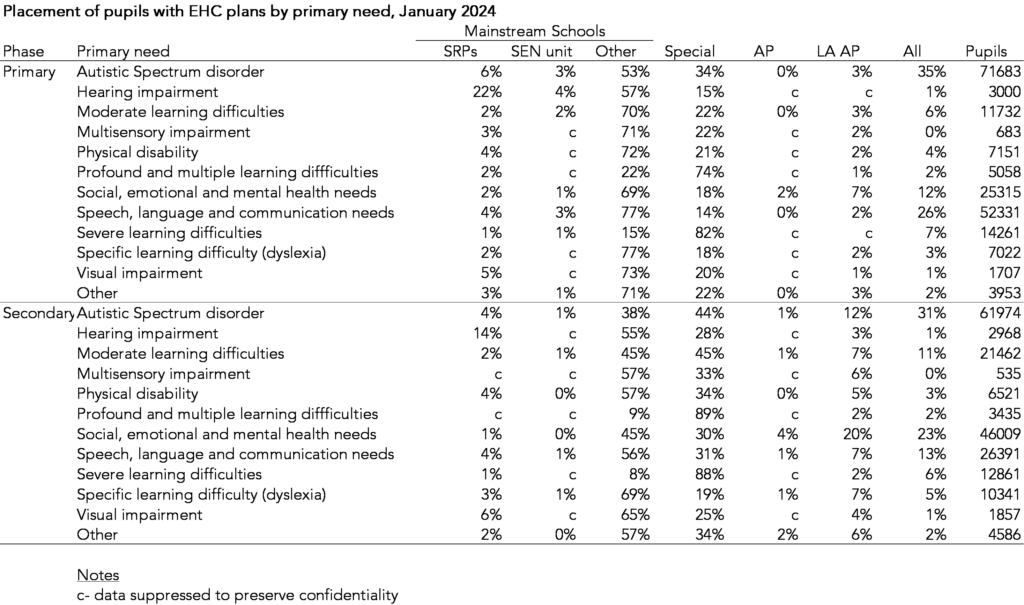

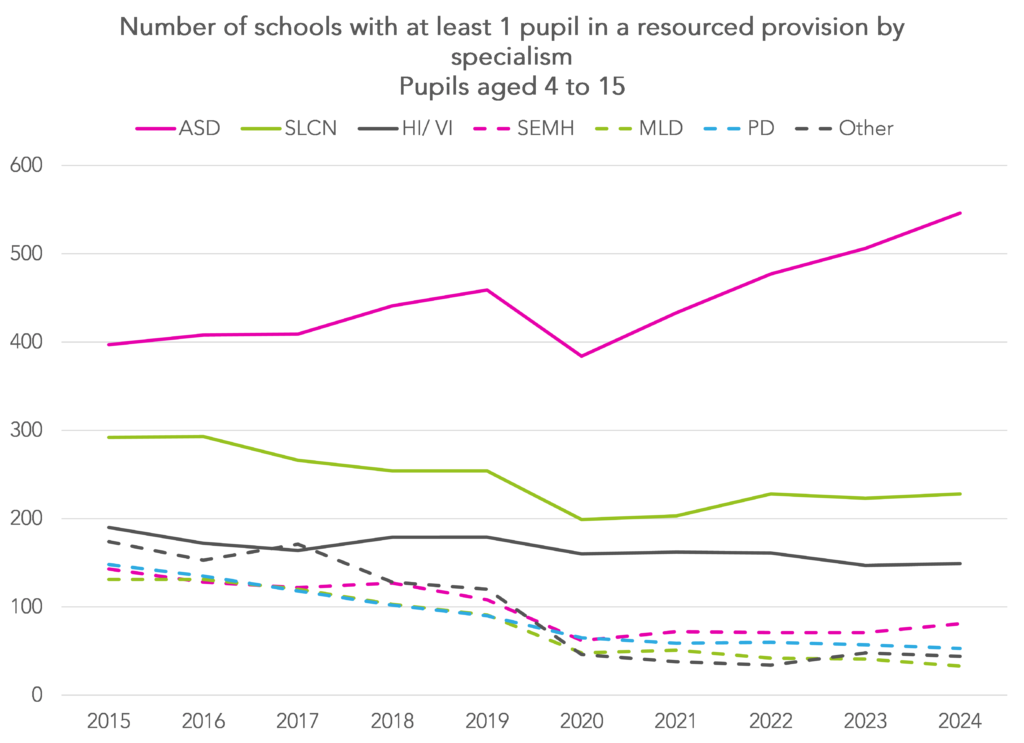

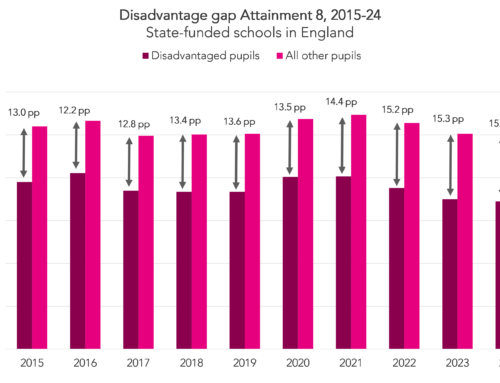
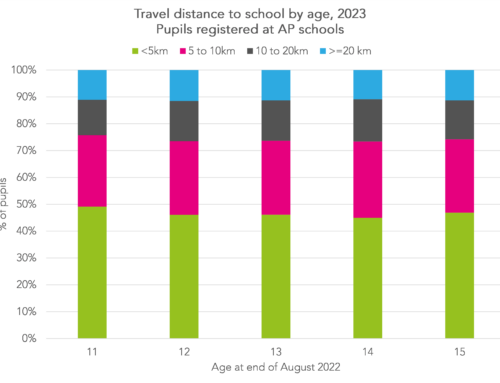
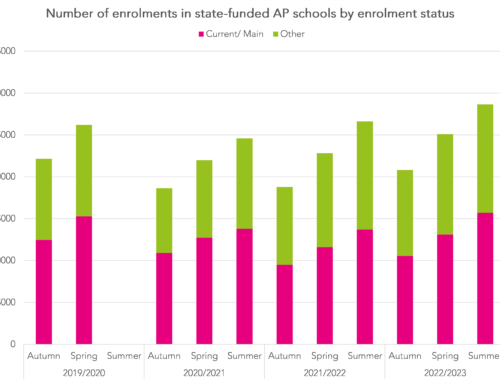
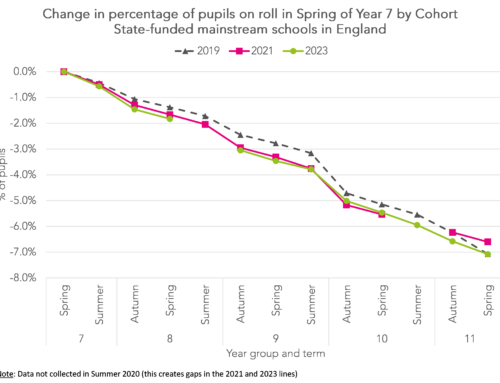
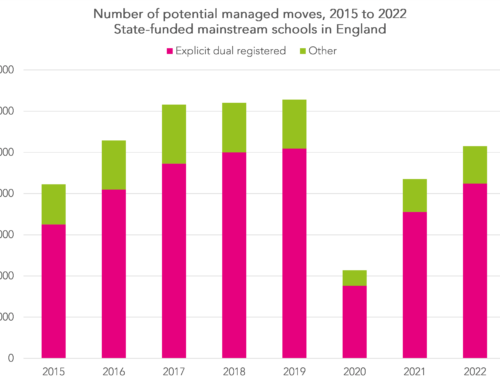
This is a really complex area for discussion. Mr Thompson’s article looks at numbers of pupils and numbers of schools. But “provision” is not necessarily a location: what about capacity of all schools to meet need, or early intervention, for example? There is also a big issue about “diagnosis” and the labelling of primary needs – we are much more precise at looking at the constellation of need than perhaps we used to be. And then there is the issue of parental expectation. But it is true that there is an issue in planning for physical infrastructure: Mr Thompson mentions Tameside, where a 60-place MLD school has just been replaced (opening last September) with a 200-place MLD/ASD school. It is already full, and as far as I know, there are no plans to increase the secondary special estate, already bursting at the seams.
Hi Claire. Thanks for taking the time to comment and sorry for the delay in responding. I totally agree it’s a complex area, far more than I can do justice to in 1500 words (or less). Beneath the national headline are a whole host of local stories, such as the example you quote. Incidentally, I’m not necessarily suggesting that places for pupils with EHC plans should be in specialist settings. But at the moment it seems there are areas of the country where something is not working and hence we have local authorities paying for specialist provision outside the state sector for fairly large numbers of young people.